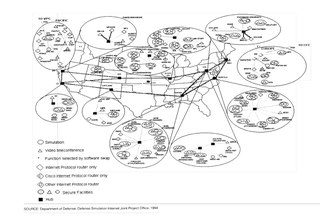ALSP Infrastructure Software (AIS)
The object-based conceptual framework adopted by ALSP defines classes of information that must be distributed. The ALSP Infrastructure Software (AIS) provides data distribution and process coordination. Principal components of AIS are the ALSP Common Module (ACM) and the ALSP Broadcast Emulator (ABE).
ALSP Common Module (ACM)
The ALSP Common Module (ACM) provides a common interface for all simulations and contains the essential functionality for ALSP. One ACM instance exists for each simulation in a confederation. ACM services require time management and object management; they include:
- Coordinate simulations joining and departing from a confederation..
- Coordinate simulation local time with confederation time.
- Filter incoming messages, so that simulations receive only messages of interest.
- Coordinate ownership of object attributes, and permit ownership migration.
- Enforce attribute ownership so that simulations report values only for attributes they own.
Time management
Joining and departing a confederation is an integral part of time management process. When a simulation joins a confederation, all other ACMs in the confederation create input message queues for the new simulation. Conversely, when a simulation departs a confederation the other ACMs delete input message queues for that simulation.
ALSP time management facilities support discrete event simulation using either asynchronous (next-event) or synchronous (time-stepped) time advance mechanisms. [3] The mechanism to support next-event simulations is
- A simulation sends an event-request message to its ACM with a time parameter corresponding to simulation time T, (the time of its next local event).
- If the ACM has messages for its simulation with timestamps older than or the same as T, the ACM sends the oldest one to the simulation. If all messages have timestamps newer than T, the ACM send a grant-advance to the simulation, giving it permission to process its local event at time T.
- The simulation sends any messages resulting from the event to its ACM.
- The simulation repeats from step (1).
The mechanism to support time-stepped simulation is:
- The simulation processes all events for some time interval .
- The simulation sends an advance request to its ACM for time .
- The ACM sends all messages with time stamps on the interval to the simulation, followed by a grant-advance to T+?T.
- The simulation sends any messages for the interval to the ACM.
- The simulation repeats from step (1).
AIS includes a deadlock avoidance mechanism using null messages. The mechanism requires that the processes have exploitable lookahead characteristics.
Object management
The ACM administers attribute database and filter information. The attribute database maintains objects known to the simulation, either owned or ghosted, and attributes of those objects that the simulation currently owns. For any object class, attributes may be members of
- Create set. Attributes minimally required to represent an object
- Interest set. Useful, but not mandatory, information
- Update set. Object attribute values reported by a simulation to the confederation
Information flow across the network can be further restricted through filters. Filtering provides discrimination by (1) object class, (2) attribute value or range, and (3) geographic location. Filters also define the interactions relevant to a simulation.
If (an update passes all filter criteria) | If (the object is known to the simulation) | | Send new attribute values to simulation | Else (object is unknown) | | If (enough information is present to create a ghost) | | | Send a create message to the simulation | | Else (not enough information is known) | | | Store information provided | | | Send a request to the confederation for missing data Else (the update fails filter criteria) | If (the object is known to the simulation) | | Send a delete message to the simulation | Else | | Discard the update data
The ownership and filtering information maintained by the ACM provide the information necessary to coordinate the transfer of attribute ownership between simulations.
ALSP Broadcast Emulator (ABE)
An ALSP Broadcast Emulator (ABE) facilitates the distribution of ALSP information. It receives a message on one of its communications paths and retransmits the message on all of its remaining communications paths. This permits configurations where all ALSP components are local to one another (on the same computer or on a local area network). It also permits configurations where sets of ACMs communicate with their own local ABE with inter-ABE communication over wide area networks.




